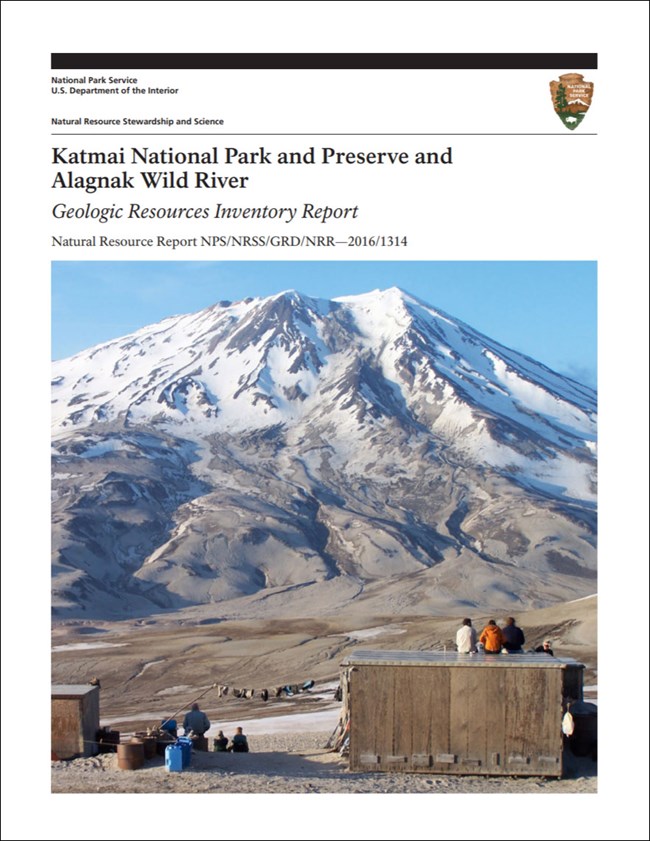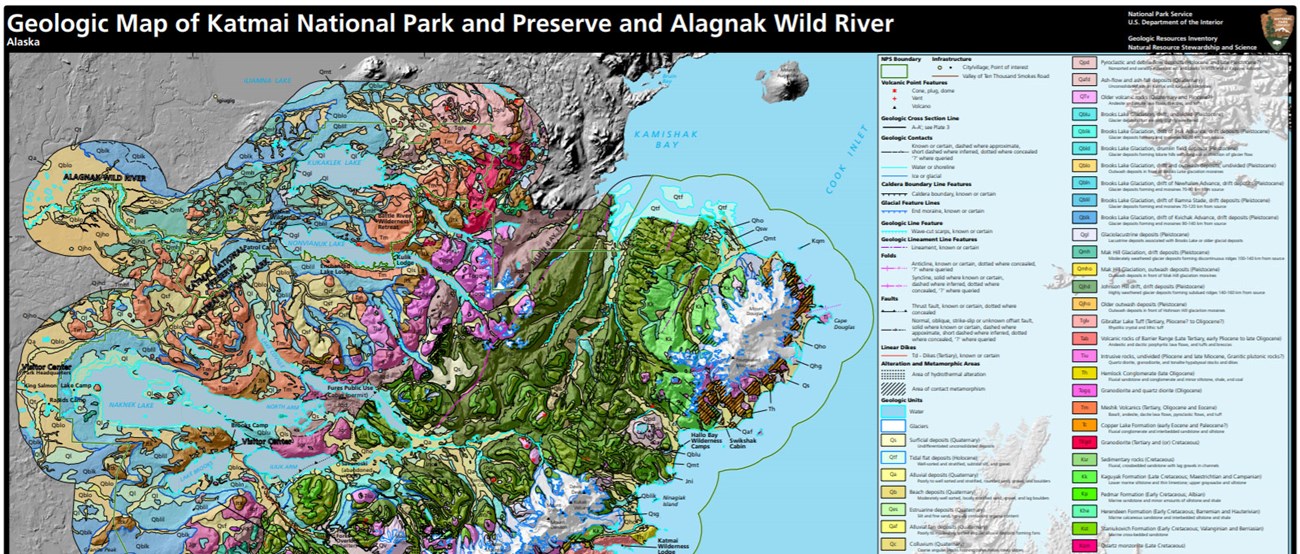Last updated: July 9, 2024
Article
NPS Geodiversity Atlas—Katmai National Park & Preserve, Alaska
Geodiversity refers to the full variety of natural geologic (rocks, minerals, sediments, fossils, landforms, and physical processes) and soil resources and processes that occur in the park. A product of the Geologic Resources Inventory, the NPS Geodiversity Atlas delivers information in support of education, Geoconservation, and integrated management of living (biotic) and non-living (abiotic) components of the ecosystem.

Introduction
Katmai National Park and Preserve (KATM) is located on the Alaska Peninsula within the active Aleutian volcanic arc in the Bristol Bay, Kenai Peninsula, Kodiak Island, and Lake and Peninsula Boroughs, Alaska. Originally established as Katmai National Monument on September 24, 1918, the park unit was re-designated as a national park and preserve on December 2, 1980 (Anderson 2017). KATM encompasses approximately 1,656,405 hectares (4,093,067 acres) of diverse landscape that contains lakes, forests, mountains, and marshlands that host a rich biological community. The park and preserve protect the remnants of the massive 1912 eruption that formed the Novarupta volcanic vent, the small Katmai Caldera, and the Valley of Ten Thousand Smokes (Hults and Fierstein 2016). Preservation of the volcanic features provides a valuable data-store for scientific analysis of the eruption and its ecological impact, response, and recovery (Hults and Fierstein 2016).
Geologic Setting
The geology of Katmai National Park and Preserve reflects one of the most geologically active areas in North America and has been influenced by the dynamic forces of plate tectonics, volcanism, glaciation, rivers, waves, and wind. The Bruin Bay Fault bisects the park unit along a NE–SW trend juxtaposing two distinctly different bedrock assemblages. Northwest of the fault, geologic units consist of Mesozoic rocks including the Kakhonak Complex, Cottonwood Bay Greenstone, Kamishak Formation, Talkeetna Formation, and intrusive igneous rocks. Younger units of the northwestern region include Cenozoic volcanic and intrusive rocks, and Quaternary glacial deposits and alluvium. Southeast of the fault, the geology is composed of gently folded, Mesozoic marine sedimentary rocks of the Shelikof, Naknek, Staniukovich, Herendeen, Pedmar, and Kaguyak Formations (Hults and Fierstein 2016). Cenozoic units of southeastern KATM include the Copper Lake Formation, Hemlock Conglomerate, Cenozoic intrusive and volcanic rocks, Quaternary glacial deposits and other unconsolidated deposits, and younger volcanic deposits associated with the historic 1912 eruption.
- Scoping summaries are records of scoping meetings where NPS staff and local geologists determined the park’s geologic mapping plan and what content should be included in the report.
- Digital geologic maps include files for viewing in GIS software, a guide to using the data, and a document with ancillary map information. Newer products also include data viewable in Google Earth and online map services.
- Reports use the maps to discuss the park’s setting and significance, notable geologic features and processes, geologic resource management issues, and geologic history.
- Posters are a static view of the GIS data in PDF format. Newer posters include aerial imagery or shaded relief and other park information. They are also included with the reports.
- Projects list basic information about the program and all products available for a park.
Source: NPS DataStore Saved Search 2915. To search for additional information, visit the NPS DataStore.
A NPS Soil Resources Inventory project has been completed for Katmai National Park and can be found on the NPS Data Store.
Source: NPS DataStore Saved Search 2987. To search for additional information, visit the NPS DataStore.
GRI Geology Image Gallery

Related Links
Related Articles
Katmai National Park
National Park Service Geodiversity Atlas
The servicewide Geodiversity Atlas provides information on geoheritage and geodiversity resources and values within the National Park System. This information supports science-based geoconservation and interpretation in the NPS, as well as STEM education in schools, museums, and field camps. The NPS Geologic Resources Division and many parks work with National and International geoconservation communities to ensure that NPS abiotic resources are managed using the highest standards and best practices available.

